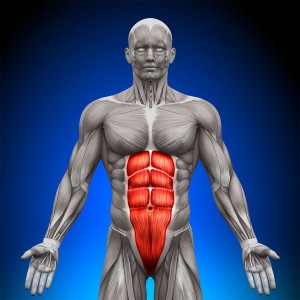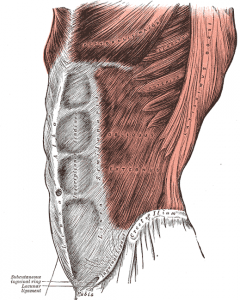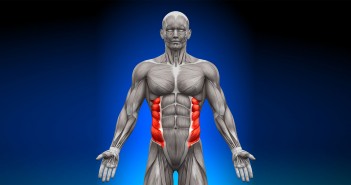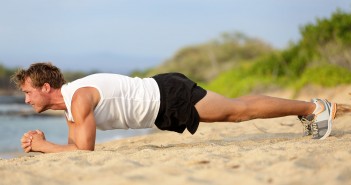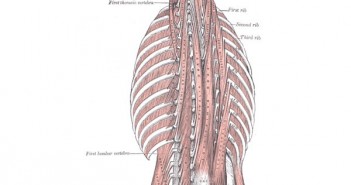The Rectus Abdominis
A strong tendinous sheath called the “linea alba,” or white line, divides the rectus abdominis down the middle, and three more horizontal tendinous sheaths give the muscle its familiar “washboard” look in very fit athletes.
The rectus abdominis helps to flex the spinal column, narrowing the space between the pelvis and the ribs. It is also active during side bending motions and helps stabilize the trunk during movements involving the extremities and head.
The External Obliques
The external obliques originate at the fifth to twelfth ribs and insert into the iliac crest, the inguinal ligament, and the linea alba of the rectus abdominis.
The external oblique muscles allows flexion of the spine, rotation of the torso, sideways bending and compression of the abdomen.
The Internal Obliques
The internal oblique muscles are a pair of deep muscles that are just below the external oblique muscles. The internal and external obliques are at right angles to each other.
The internal obliques attach from the lower three ribs to the linea alba and from the inguinal ligament to the iliac crest and then to the lower back (erector spinae). The lower muscle fibres of the internal obliques run nearly horizontally.
Along with the external obliques, the internal obliques are involved in flexing the spinal column, sideways bending, trunk rotation and compressing the abdomen.
Because of their unique alignment, at right angles to each other, the internal and external obliques are referred to as opposite-side rotators. When the trunk rotates left, the external obliques (on the right) contract. When the trunk rotates to the right, the external oblique fibres (on the left) activate the movement.
The Transversus Abdominis
The deepest layer of abdominal muscles is called the “transversus abdominis”, or TVA for short. The transverse abdominal muscle wraps around the torso from front to back and from the ribs to the pelvis. The muscle fibres of the transversus abdominis run horizontally, similar to a corset or a weight belt.
This muscle doesn’t help move the spine or the pelvis, but it does help with respiration and breathing. This muscle helps facilitate forceful expiration of air from the lungs, stabilizes the spine and helps compress the internal organs.
Abdominal Muscle Exercises
Mobility exercises:
Cats and Dogs Exercise (Rectus Abdominis)
Cobra Exercise (Rectus Abdominis)
Figure 8 on an Exercise Ball (Rectus Abdominis and Transversus Abdominis)
Heel Touch Exercise (Transversus Abdominis)
Pelvic Thrust on an Exercise Ball (Rectus Abdominis and Transversus Abdominis)
Posterior Pelvic Tilt Exercise (Rectus Abdominis)
Straight-Leg Heel Touch Exercise (Transversus Abdominis)
Supine Pelvic Tilt Exercise (Rectus Abdominis)
If you have any questions or comments about this or other articles on Golf Loopy, please send us an email.
You May Also Like…
Overview of a Great Golf Swing, which summarises the correct movements in a great golf swing, and how the abdominals help to power and stabilise the golf swing.
Golf Swing 101. Setup: Basic Posture, which explains why good posture is good for your golf swing, and how the abdominals should be pulled in properly.
Golf Swing Drill 101. Setup: Perfect Posture and Connecting to Your Core, which describes how to achieve perfect posture, including how your abdominals should activated by pulling them in and up.
Golf Anatomy and Kinesiology, a collection of articles describing the roles of the muscles involved in the golf swing.
Core muscles, which describes the muscles that run the length of your trunk and torso.
Oblique muscles, which describes in more detail your side abdominals, which help you to bend from the side or twist your torso, and their role in the golf swing.


